Procol • April 15, 2025
Know Why Procurement Compliance Is Essential for an Organization
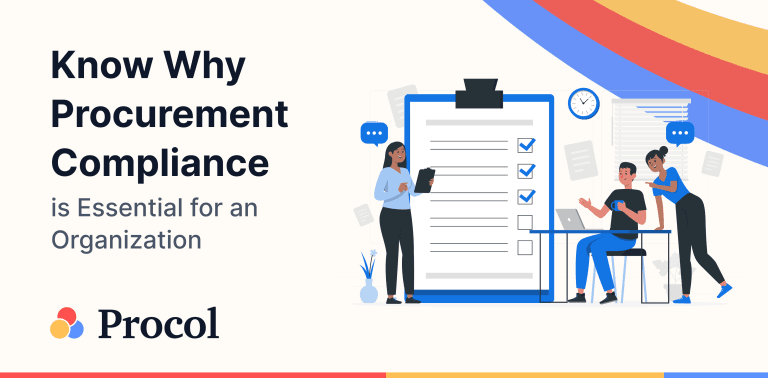
Introduction
Businesses look for quick results, and due to this, they tend to ignore the aspects that are important for business success. Procurement compliance is one among them. However, a few risks can hinder your business, such as not implementing rules and regulations, the business’s reputation, financial loss, etc., that need proper attention.
The top priority for a business owner is its success, which can be achieved by ensuring proper compliance in executing business processes. This ensures that all spending flows are conducted according to company-approved policy.
Therefore, embedding procurement governance and compliance in your organization is pivotal for securing various procurement activities. Let’s dig deep to understand procurement compliance and will shed light on its different elements, strategies, and more. Keep reading!!
What is procurement compliance?
Compliance means following all the pre-established rules and guidelines, and the procurement team brings together the compliance function with the procurement function for business efficiency as well as procurement fraud.
Purchase order compliance ensures that employees of an organization must follow all the rules and regulations required to buy goods and services to ensure all the processes are conducted ethically.
In simple words, procurement compliance means ensuring that all procurement activities ( buying goods and services) within the procurement lifecycle adhere to the company’s compliance rules and regulations. Thus, to ensure procurement compliance, companies must know compliance rules and regulations like labor laws, anti-corruption laws, etc.
Why Is Purchasing Compliance Important in Procurement?
Purchase order compliance is essential, regardless of the organization’s size. It is taken into practice to mitigate the risks associated with procuring goods and services. Implementing compliance lets companies stay away from fraud, corruption, and overspending. If an organization prevents itself from following compliance, it may lead to fines, and lawsuits, or may damage the company’s reputation as well.
Having compliance in procurement processes allows transparency in the procurement processes to gain mutual benefit. If an organization prioritizes compliance, it will protect itself from legalities and reputational risk and promote integrity and responsibility within its procurement teams. Adhering to all the procurement governance and compliance set standards to streamline processes will, in turn, lead to saving money, adding value, healthier supplier relationships, boosting operational efficiency, and long-term sustainability in the marketplace.
Types of Procurement Compliance
Procurement Compliance requirements differ and change according to the industry, procurement activities, and vendors. Check out below the various types of procurement compliance:
Price and Discount Compliance: Procurement price and discount compliance include various measures involved in discounts, bonuses, and service prices. Discount compliance is given upon reaching a certain buying threshold. Price compliance involves examining billed and contracted line item prices in items, services, or catalogues. Bonus payment compliance is a check at the beginning of a contract or a renewal bonus.
-
Supplier Compliance: Procurement supplier compliance means the organization must buy from the ‘designated’ suppliers that are carefully selected by the esteemed procurement team using sourcing compliance. These approved suppliers contract with the company for the needed services and goods, ensuring quality and reliability.
-
Spend Compliance: It is a blend of contract and supplier compliance. It can be defined as the percentage of spending influenced by procurement employing the selected contract or supplier. If the spend is not influenced by purchasing and is protected from contracts and suppliers not set up by procurement for the goods and services, it is called ‘rogue’ spend.
-
Contract Compliance: It is similar to supplier compliance. The only difference between procurement contract compliance and supplier compliance is that procurement contract compliance measures the percentage of spend purchased via contracts established with procurement involvement.
How to measure Compliance with procurement?
Organizations can use various metrics to measure and enhance purchasing compliance effectively. Here are the key measures outlined below that can help keep track of compliance:
-
Spend Under Management: It refers to the part of total company expenditures the procurement team controls. A higher spend under management metric represents better spending control and a higher level of compliance with internal purchasing policies.
-
Contract Compliance: Procurement contract compliance measures how frequently vendors adhere to the terms written in the contract and how completely the contracts are fulfilled. Thus, enhancing vendor compliance with contract terms improves overall procurement compliance and helps to safeguard businesses against potential losses.
-
Process Compliance: This metric evaluates how often the company adheres to standard procurement rules and regulations when purchasing goods and services. It is essential for organizations where independent decision-making authority can lead to non-compliance. By tracking compliance, organizations can identify areas for improvement, highlighting the team’s crucial role in ensuring constant adherence to procurement procedures.
-
Supplier Count: An organization must retain an optimal number of suppliers by adhering to sourcing compliance. Here, supplier count signifies the number of suppliers on the list of approved vendors. Having too many suppliers on the vendor list improves the risk of precluding strategic supplier relationships. In contrast, only some suppliers may leave the organization powerless during operational shortages or troubles.
-
Invoice-to-PO Matching: It estimates the percentage of invoices that match the purchase order number in the procurement system. The purchase order process is consistently obeyed if a company has a high invoice-to-PO matching metric. It reflects the level of compliance with procurement procedures and enables pinpointing any gaps or problems in the process.
-
Time To Compliance: This means the average time required to solve compliance issues. The company will use efficient problem-solving and a proactive approach if the time is short.
-
Audit Completion Rate: It measures the percentage of scheduled and completed audits on time and within scope. Having a high completion rate means the company is committed to internal control and risk management.
-
Training Completion Rate: The percentage of employees who completed the compliance training programs. Having a high rate ensures that employees understand the roles in maintaining compliance.
How To Develop A Procurement Compliance Framework?
Every organization looks to build a framework for compliance that works wonders for them. Here are the steps to create a compliance framework:
Know your business compliance issues: Is there any specific area in your business where you are facing programs? For example, no team or department shares information with each other.
1. Rank your Compliance Priorities:
Focusing on old practices might cause continuous issues. For example, some compliance issues need immediate attention and keep you busy, and vice versa. Besides this, you must focus on “so what?” This will help you identify when you’re devising a process for the sake of the process and when it is actually adding value.
2. Research for a Better Compliance Solution:
To do so, you need to understand your company’s compliance issues, like developing value-driven processes, better tools that align with your processes, or better training on the company’s tools.
3. Understand Your Resources:
Understand your team’s organizational culture, abilities, and skill sets, such as whether employees are open to trying new things, whether some departments are easier to work in than others, etc. All of these will play a significant role in optimizing procurement compliance.
4. Map Complexity:
Check items in the list and map them according to their difficulty, such as budget, internal expertise, the need for approval from multiple stakeholders, etc.
5. Create High-Value Targets list:
Look for things under “Low Impact, High Difficulty and tackle them first to gain momentum.
6. Define successful procurement compliance:
Now that you have elements of an action plan, consider what success in purchase order compliance would look like.
7. Create Timelines:
Once you understand what success means to your organization. Estimate how long it will take to reach your procurement compliance goals.
8. Keep Track:
To track, you must have processes or tools that give you visibility into how you work against your timelines and goals.
What Are The Key Benefits To Ensure Procurement Compliance?
Procurement compliance ensures that procurement activities are conducted as per the rules and laws set by the company. Whatever the organization’s goal, procurement companies benefit from it in different ways mentioned below:
-
Protect from fraud and corruption: If a company follows all the procurement governance and compliance regulations and policies, it minimizes the opportunity for bribery, kickbacks, and conflicts of interest, which will protect the organization from financial losses and other legal consequences.
-
Spending Under Control: Optimized processes promote competitive bidding via eAuction, helping secure profitable deals and control unnecessary expenses.
-
Improved supply chain resilience: Compliance, such as ethical sourcing and risk management, ensures a safe supply chain, minimizes troubles and ensures uninterrupted operations.
-
Streamlined processes: If a company has a transparent policy, the procurement workflow will go smoothly, reducing delays and confusion. This will lead to speedier delivery, enhanced resource allocation, and project efficiency.
-
Reduce unuseful spending: Effective compliance minimizes unauthorized purchases, improving budget control predictability.
-
Vendor Relationships: To strengthen vendor relationships, companies need to be transparent and ensure they follow procurement policies. This will further enhance communication and trust.
Best Practices To Ensure Procurement Compliance
Develop organization procurement policies: If companies have internal procurement governance and compliance laws and regulations, vendors and the procurement team need to follow them. There are companies that maintain procurement compliance checklists to make sure it be being followed.
-
Train your employees: Companies with high-performing procurement teams use software tools to streamline procurement processes and compliance. Software is effective and works for organizational success if your employees know how to use it. Thus, timely training will help them better understand the features and capabilities of tools.
-
Establish strong internal controls: These controls will set the tone for all procurement processes, from understanding procurement needs to conducting vendor solicitation and bids. They will create a frictionless workflow to obtain procurement compliance requirements in a timely and cost-effective way.
-
Communicate with your suppliers: Maintaining a proper conversation with suppliers eliminates the risk of delays and unorganized tasks. Better communication lets them understand company policies mentioned in the procurement compliance checklist for better quality.
-
Monitor and measure compliance: Conducting procurement audits will meet the practices and policies. They also assess vendor relationships and hunt down out-of-process spending. Thus, companies must look for strategies to improve compliance if there are areas where compliance is low.
-
Maintaining records accurately: Accurate records offer transparency and accountability. It also helps organizations monitor and evaluate procurement activities to identify potential compliance issues.
-
Understand non-compliance risks: If a company does not follow compliance rules, it can lead to financial losses, security issues, fines, damage to the company’s reputation, and much more.
Conclusion
Procurement compliance streamlines a business’s procurement process by protecting it from various risks, such as fraud, overspending, etc. Thus, if a business follows an ethical approach to purchase order compliance it will enhance procurement operations. Therefore, by implementing the essential practices, an organization can ensure its procurement practices’ legal and ethical integrity. This contributes to the organization’s efficiency and financial health.
Explore more from Procol
Discover expert tips, how-to guides, industry insights, and the latest procurement trends.
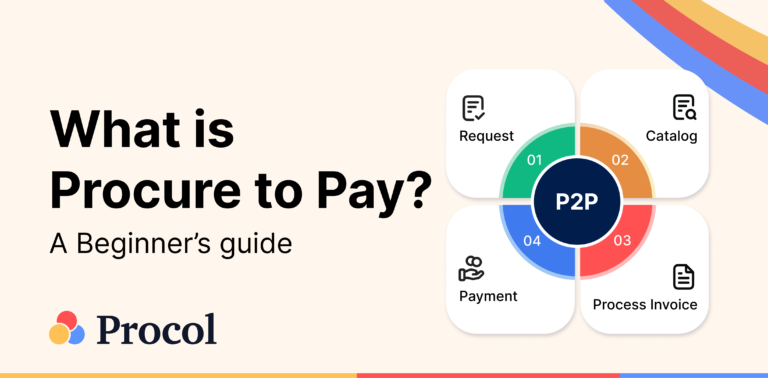
What is Procure-to-pay (P2P)? An Ultimate Guide
Procure to pay is the process from procurement of materials needed...
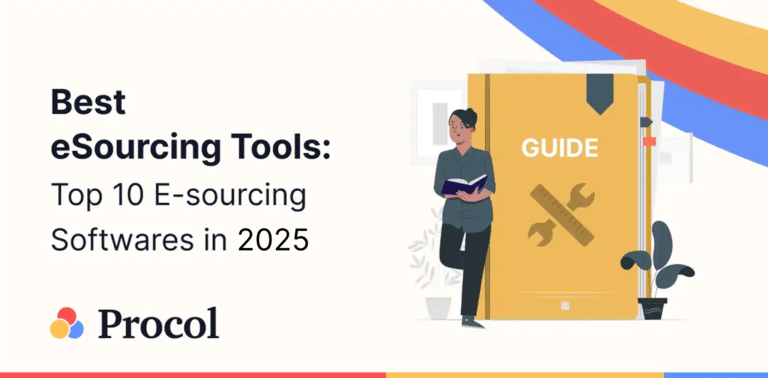
Best eSourcing Tools: Top 10 eSourcing Software in 2025
Discover top 10 e-sourcing tools and esourcing platforms necessary for efficient...
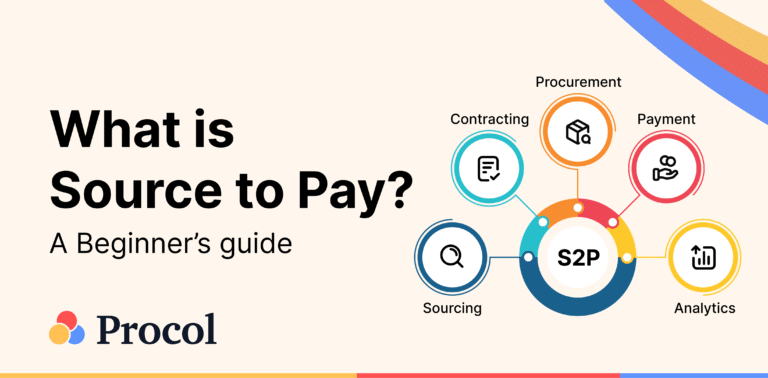
What is Source-to-pay in 2025? An Ultimate Guide
Source to pay is the process of sourcing vendors to procure...









